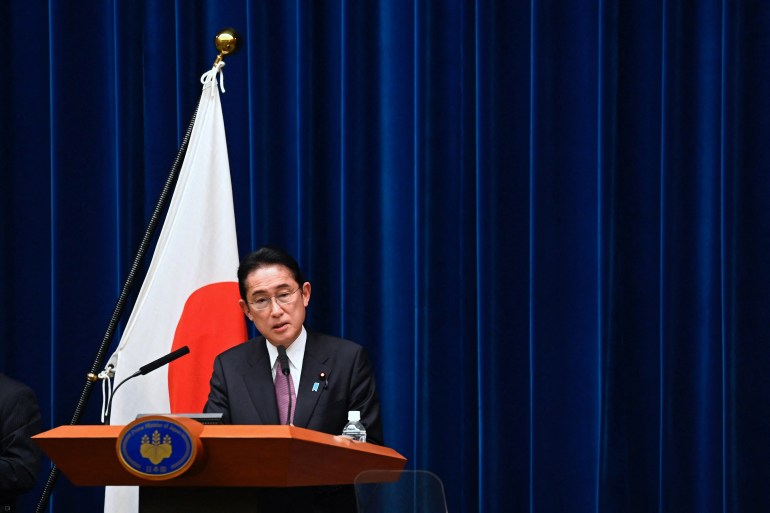Japan unveils record defence budget amid regional security fears
The cabinet’s nod for a 20-percent rise in military spending is a deviation from pacifist post-WWII self-defence policy.

Japan will boost its defence budget for 2023 to a record 6.8 trillion yen ($55bn), or a 20-percent increase, in the face of regional security concerns and threats posed by China and North Korea.
Prime Minister Fumio Kishida’s cabinet approved the budget on Friday of a total 114.4 trillion yen ($863bn), from next April, which was pushed up mainly by the hefty increase in military spending and higher social security costs for a fast-ageing population
Keep reading
list of 3 itemsWhat does Japan’s military expansion mean for the region?
North Korea slams Japan’s military buildup, promises action
This is part of a controversial new National Security Strategy that aims to double Japan’s defence spending to 2 percent of gross domestic product (GDP) by 2027.
The new spending target follows the NATO standard and will eventually push Japan’s annual budget to about 10 trillion yen ($73bn), the world’s third biggest after the United States and China.
The strategy aims to provide Japan with a “counterstrike capability” that can pre-empt enemy attacks and protect itself from growing risks from North Korea, Russia and China, who they fear may attempt to invade Taiwan.
On Friday, North Korea fired two short-range ballistic missiles, according to South Korea’s military, the latest in a recent flurry of weapons tests that took place days after a joint air drill by Seoul and Washington.
Japan’s budget, which is still pending parliamentary approval, includes the purchase of US-made Tomahawks at 211.3 billion yen ($1.6bn) and other long-range cruise missiles that can hit targets in China or North Korea.
Additionally, Japan will pay the United States 110 billion yen ($830m) for equipment and software needed to launch the Tomahawks, as well as fees for the technology transfer and staff training in the coming year, defence officials said.
A deviation from Japan’s pacifist constitution
The strategy is an historic change from Japan’s exclusively self-defence policy since the end of World War II.
China, with its rapid arms buildup, increasingly assertive military activity and rivalry with the US, presents “an unprecedented and the greatest strategic challenge” to the peace and security of Japan and the international community, the strategy stated.
Tomahawks will be deployed over two years from 2026 to 2027 on advanced Aegis radar-equipped destroyers with vertical launch systems for ship-to-surface attacks, defence officials said.

Japan will also buy more foreign-developed standoff missiles for launch from warplanes: a 500km (310-mile) range Joint Strike Missile from Norway for F-35A fighters and Lockheed Martin’s Joint Air-to-Surface Standoff Missile with a range of about 900km (560 miles), for upgraded F-15s.
Japan will spend 94 billion yen ($710m) next year to work on upgrading and mass production of Type-12 land-to-ship guided missiles developed by Mitsubishi Heavy Industries for deployment within the next few years.
To reinforce strike capability and range, Japan is adding eight more F-35Bs at 143.5 billion yen ($1.08bn) capable of short takeoffs and vertical landing on either of the two formerly helicopter carriers Izumo and Kaga that are being retrofitted so they could be operated jointly with the US military.
Over the next five years, Japan will spend about 5 trillion yen ($37bn) on standoff, or long-range missiles, with deployment beginning in four years.
Annual spending for 2023 on long-range ammunition alone will be tripled from this year to 828 billion yen ($6.26bn).
Japan will develop other types of arsenals, such as hypersonic weapons and unmanned and multi-role vehicles, for possible collaboration with the F-X next-generation fighter jet Japan is developing with Britain and Italy for deployment in 2035.
The defence ministry is also developing arsenals designed for defending remote southern islands, including a Japanese-controlled East China Sea island disputed with China.
Japan will spend about 100 billion yen ($7.6m) next year also to beef up cybersecurity to protect Japanese defence technology and industry.
Another key purchase is unmanned aerial vehicles for assaults and reconnaissance. Defence officials said they plan to test a number of foreign-developed UAVs, including Turkish-made Bayraktar drones used in Ukraine, as well as those from Israel, the US, and home-developed Fuji Imvac.
Japan says counterstrike capability is indispensable and constitutional if it responds to signs of an imminent enemy attack.
But experts say it is extremely difficult to conduct such an attack without risking blame for striking first. Opponents say strike capability goes beyond self-defence under Japan’s pacifist post-World War II constitution, which limits the use of force strictly to defend itself.
In 2015, then-Prime Minister Shinzo Abe altered the constitutional interpretation of the principle. The change allows Japan to defend its ally, the US, in what is known as collective self-defence, providing a legal basis for Japan to build up its military and expand the roles it performs.